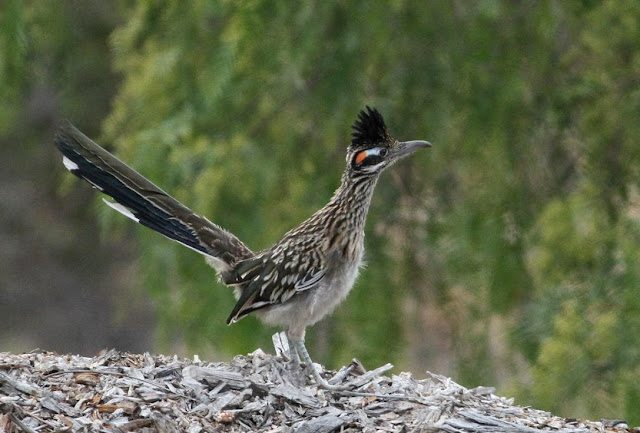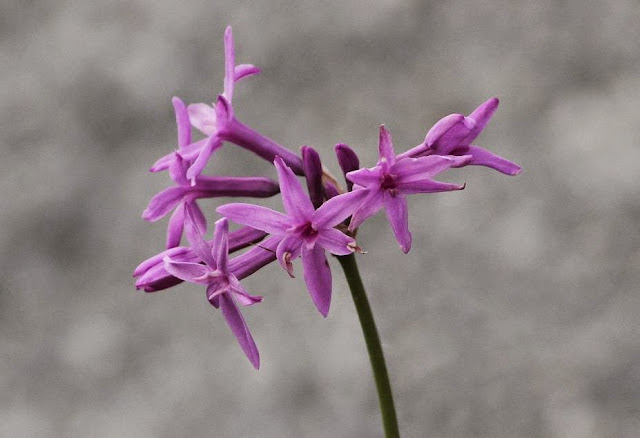Retro blog: Originally posted May 2014.
For the last few years my friend Betty has been telling
me about the Roadrunners that come to visit her yard and every time I go there
to get some shots it has been quite disappointing.. most of the time I don't
even get a glimpse of those elusive birds...
My lunch invitation over at Betty's house in San Pasqual
is always a treat. Her husband is a great cook and today he was cooking us lunch
but the excitement was that Betty spotted 6
Roadrunners in her yard yesterday!! I
am hoping to spot a few today... just as I entered her driveway there it was an
adult Roadrunner standing by the driveway. I parked the truck, grabbing my
camera and hurried down to the area but it flew into the canyon nearby. But
knowing Betty had seen four youngsters I kept searching. Sure enough I spot
another Roadrunner standing on her garden wall. Looks
like one of the youngsters. My first photo of the youngster!
Got a few close-ups. Greater Roadrunner,
Geococcyx californianus also known
as "chaparral cock" the state bird of New Mexico. Roadrunners are about 23 inches long and have a wingspan of 22 inches. Weighs about 13 ounces. Males are
slightly bigger than females.
These birds are noted in the Southwest
Indian legends for their "speed" (they can run faster than 15 mi per hr) and
"bravery". They kill and eat rattlesnakes and are known
for their endurance. The Hopi and other Pueblo
tribes consider the Roadrunners medicine
birds. They believe that they could protect them against evil
spirits. The Roadrunners unusual X
shaped footprints are used as sacred symbols to ward off evil spirits,
partly because of the protective power of the bird and partly because
of the X shape of the tracks which conceals the
direction the bird is headed thus throwing evil spirits
off-track.
Roadrunners are used as clan animals in some Native
American cultures such as the Zuni tribe (whose Roadrunner name is Poye-kwe).. and many other Pueblo tribes of New Mexico. Stylized roadrunner
tracks have been found in the rock art of ancestral Southwestern tribes
like the Anasazi and Mogollon cultures. A flight shot...
It had enough of my camera snapping near him
and disappeared down the canyon to join the others.
Feeling very happy to have a few shots of the youngster,
I went and told Betty I finally saw and got a few shots of her
Roadrunner!
The lunch was terrific and we were sitting around the dining table just having a nice conversation when I spotted this youngster directly behind Betty's husband's head... through the dining room window!!! LOL... all they heard was OMG, as I dove for my camera and went
The lunch was terrific and we were sitting around the dining table just having a nice conversation when I spotted this youngster directly behind Betty's husband's head... through the dining room window!!! LOL... all they heard was OMG, as I dove for my camera and went
out the door almost tripping down her stairs positioning
myself to get the best shot possible. Here is a shot of the second youngster, he is
a cutie.
They say that birds know who belongs in the area and he is
giving me that "I don't know you" look. He decides to head back
towards the canyon.
Roadrunners' feathers were traditionally
used to decorate Pueblo cradleboards as spiritual protection for the baby. Mexican Indian tribes consider the bird as sacred and never killed them but
Mexican Indians used the meat of the roadrunner as folk remedy to cure illness
or to boost stamina and strength. A few more shots and a
close-up.
Instead of flying off, he decides to run on the ground,
stopping every 10 feet or so. This shot was right in front of Betty's front
door.
He makes his way to her flower garden.
Gives me a nice pose.
A purple flower is in my way but I still manage to snap a
shot of the turquoise and orange makings behind his eyes. It shows when he
raises his crown feathers.
The American Kestrel has a nest nearby and started
scolding the Roadrunner to leave the area.
Look at those adorable eyelashes...
He runs down towards the canyon...
Stops for a second looking for his family... Roadrunners forage on the ground feeding on reptiles, birds, small
mammals, insects, scorpions and spiders, some fruits are consumed. These birds
can live for about 7 years. A pair will build their nest
on the ground using thorny sticks and lined with leaves, grass feathers,
snakeskin, etc.. the male will gather the materials and
the female will arrange them... she lays a clutch of 3
to 6 eggs which both parents incubate for 19 -20 days to hatch... (only the male
will incubate at night). The young will fledge in 14-25 days. The fledglings remain nearby to forage with
their parents for another 30 to 40 days.
There's one waiting for him across the street near the
canyon...
These youngsters maybe fledglings ready to take off on
their own. Interesting facts... there are salt glands located
at the front of their eyes and these Greater Roadrunners are able to
excrete salt from its blood also, It is very difficult to track a roadrunner by
looking at their tracks.. due to having
zygodactyl feet... where two
toes face forward and two face
backward creating the X shaped tracks.
Another one appears from Betty's garden and it's also
moving fast towards the canyon...
Notice the heavy bill. When they grab a large prey, they
will repeatedly beat the animal on a hard surface while they are holding them securely in their beaks before
consuming.
I get one shot as it poses in the classic Roadrunner stance...
It disappears down the canyon to join the others...
Look who is bringing lunch to his nestlings... it's the
male American Kestrel with a nice big lizard in his beak! I thank Betty and her husband for a terrific lunch and
head for home. I'm sure glad they understand my passion for birds
and photographing them and don't think it's "strange" when I
bolt out the door after a bird in the middle of a conversation. Hope I get invited back. Lol...I want to see the Kestrel
nestlings too. : ))
Have a nice weekend everyone!






















No comments:
Post a Comment